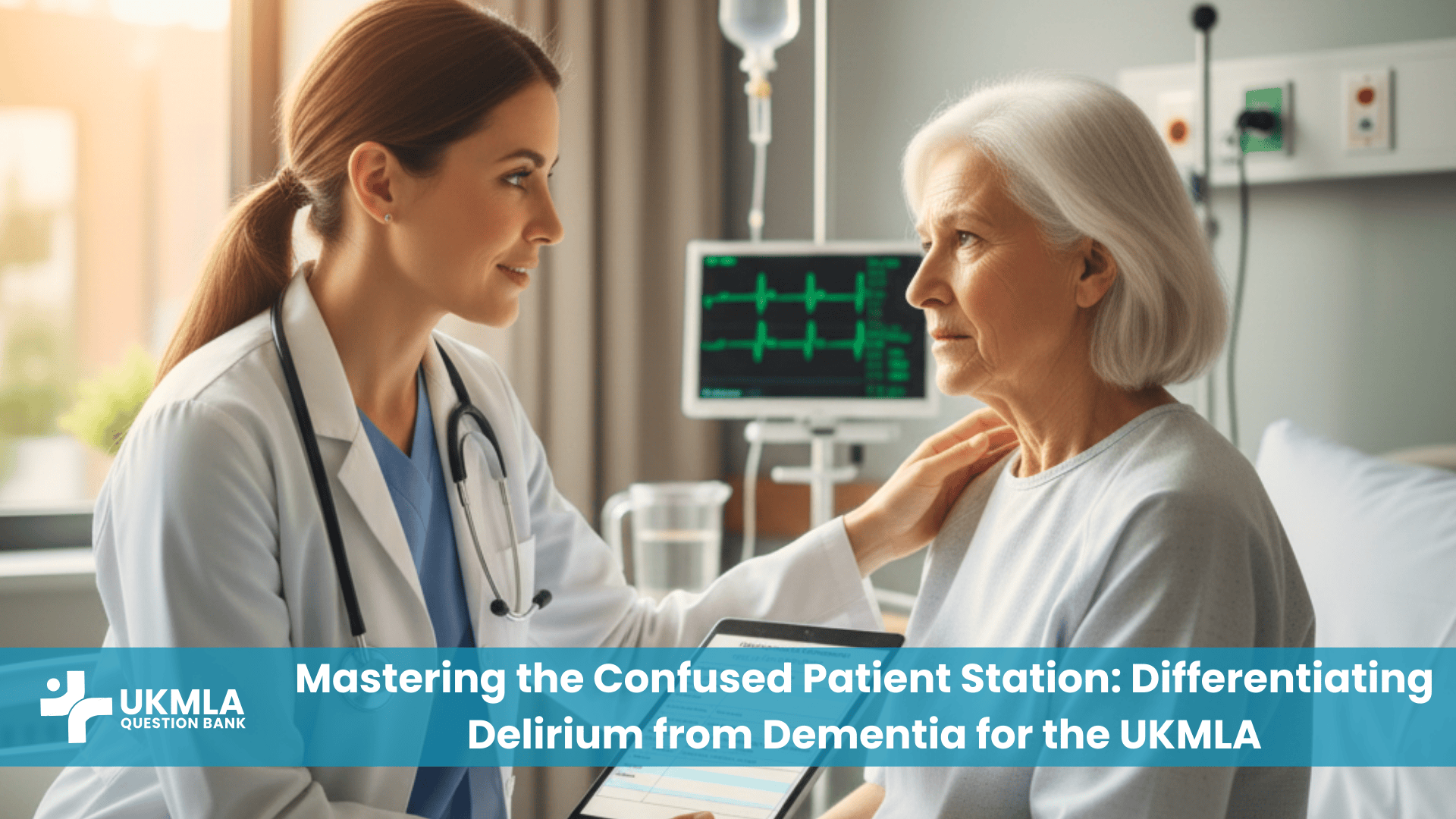Introduction
Understanding the differences between delirium vs dementia UKMLA candidates will find is a cornerstone of both geriatric and emergency medicine, and a frequently tested high-yield topic. The “confused patient” is a classic scenario you will face countless times, both in your exams and on the wards. It’s a presentation that demands sharp clinical acumen, as the ability to correctly distinguish between an acute, reversible medical emergency and a chronic, progressive neurological condition is fundamental to safe and effective patient care. Misdiagnosing delirium as a simple progression of dementia can have devastating consequences.
This guide is designed to equip you with a clear, robust framework to confidently navigate this complex clinical problem. We will define both delirium and dementia, explore their underlying causes, and then dive deep into the five essential differences that will allow you to tell them apart. Finally, we will provide a practical structure for assessing the confused patient in a UKMLA context, ensuring you can apply your knowledge under pressure and demonstrate the skills of a competent and compassionate junior doctor.
Table of Contents
ToggleUnderstanding Delirium: The Acute Emergency
The single most important thing to remember about delirium is that it is a medical emergency. It is a sign of underlying physiological distress—an organ dysfunction of the brain. It is not simply “being a bit confused.”
Defining Features: Acute Onset and a Fluctuating Course
Delirium is an acute confusional state that develops over hours to days. This rapid change is a red flag. A family member will often say, “They were perfectly fine yesterday, doctor.” Another hallmark feature is its fluctuating course. A patient with delirium may be lucid and calm in the morning but become agitated and disorientated by the evening. This waxing and waning of symptoms is characteristic and a key differentiator from dementia. According to the official NICE guideline on Delirium, this is a core diagnostic feature.
Uncovering the Cause: The “PINCHES ME” Mnemonic
Delirium is a symptom, not a final diagnosis. Your job is to find the underlying cause, which is often reversible. The “PINCHES ME” mnemonic is a useful tool to run through the common triggers:
Pain
Infection (e.g., UTI, pneumonia)
Nutrition (e.g., vitamin deficiencies)
Constipation
Hydration (dehydration)
Endocrine/Electrolytes (e.g., thyroid issues, sodium imbalance)
Stroke
Medication (polypharmacy, new drugs, opiates, anticholinergics)
Environment (unfamiliar settings, ICU)
A patient with a new infection is a classic cause, making it important to review your infectious disease essentials.
Understanding Dementia: The Chronic Decline
In contrast to the acute storm of delirium, dementia is a slow, progressive neurological winter. It is a chronic and largely irreversible syndrome of cognitive decline.
Defining Features: Insidious Onset and Progressive Decline
Dementia develops insidiously, with changes occurring over months and years. Family members may struggle to pinpoint exactly when the symptoms started. The course is one of progressive decline; while the speed of progression can vary, it does not fluctuate dramatically day-to-day like delirium. The patient’s cognitive function is on a steady downward trajectory. While memory impairment is a famous feature, dementia affects all cognitive domains, including language, problem-solving, and executive function.
A Brief Look at Common Types
It’s helpful to be aware of the main types of dementia, as this is a core part of the UKMLA neurology essentials:
Alzheimer’s Disease: The most common form, typically starting with short-term memory loss.
Vascular Dementia: Caused by cerebrovascular disease (e.g., strokes), often with a “stepwise” decline.
Lewy Body Dementia: Characterised by visual hallucinations and parkinsonism. Notably, the course can fluctuate, making it a tricky differential.
Delirium vs Dementia UKMLA: The 5 Essential Differences
To ace the confused patient station, you must be able to rapidly compare and contrast the key features of these two conditions. This table summarises the core differences.
Table 1: Comparing Delirium and Dementia
| Feature | Delirium | Dementia |
|---|---|---|
| 1. Onset | Acute (hours to days) | Insidious (months to years) |
| 2. Course | Fluctuating | Slowly Progressive |
| 3. Attention | Impaired & Distractible | Intact until late stages |
| 4. Consciousness | Clouded / Altered | Alert until late stages |
| 5. Reversibility | Often Reversible | Irreversible |
Assessing the Confused Patient: A UKMLA Framework
A structured approach is essential when faced with a confused patient in a CPSA station.
History Taking: The Power of Collateral Information
You cannot diagnose delirium or dementia without a collateral history. The patient themselves will likely be a poor historian. Speaking to family, friends, carers, or nursing staff is non-negotiable. This is the only way to establish the patient’s baseline cognitive function and the timeline of their deterioration. A guide on history taking in the CPSA can be invaluable here.
Blockquote: According to the GMC’s guidance on Decision-making and mental capacity, “You must assess a patient’s capacity to make a particular decision at the time it needs to be made.” This is a core part of managing confused patients, and a thorough assessment is the first step.
Key Examinations and Cognitive Screening Tools
Always perform a full physical examination from head to toe. You are looking for the cause of the delirium—be it a fever, a new heart murmur, or signs of a stroke. Cognitive screening tools like the AMTS (Abbreviated Mental Test Score) or MoCA (Montreal Cognitive Assessment) can help quantify the level of cognitive impairment, but they do not distinguish between delirium and dementia on their own.
It’s important to remember that a patient in a state of delirium can often be frightened, which may present as agitation or anger. Managing this requires a specific skill set. For a detailed guide on handling these challenging interactions, see our post on The Angry Patient Station: A UKMLA CPSA Guide to De-escalation.
Essential Bedside Investigations
To find the cause of delirium, you need a “delirium screen.” This typically includes:
Bloods: FBC, U&Es, LFTs, CRP, TFTs, calcium, glucose, B12/folate.
Infection screen: Urine dipstick & MSU, chest X-ray, blood cultures.
Other: ECG to look for arrhythmia or ischemia.
Mastering how to interpret this clinical data is a vital skill.
Frequently Asked Questions (FAQ) about Delirium and Dementia
Yes, this is very common. A patient with pre-existing dementia has a much lower physiological reserve, making them highly susceptible to developing delirium from a minor insult like a UTI. This is often called “delirium superimposed on dementia.”
The Abbreviated Mental Test Score is a 10-point cognitive screening tool commonly used at the bedside. It assesses orientation, memory, and attention. A score of less than 8 suggests cognitive impairment.
While we often picture delirium as a state of agitation (hyperactive), it can also present as a quiet, withdrawn, and sleepy state (hypoactive). This form is often missed and misdiagnosed as depression.
Not always. A CT head scan is typically indicated if there is a history of a fall, new focal neurology, or if no other cause for the delirium can be found after initial investigations.
Sundowning is a term used to describe the worsening of confusion and agitation in patients with dementia as daylight begins to fade.
This is a critical distinction. A patient with expressive dysphasia (e.g., from a stroke) may struggle to find words, making them appear confused, but their underlying cognition and attention may be intact. A formal GCS and neurological exam can help.
To a large extent, yes. Proactive measures in hospital, known as “delirium precautions,” can significantly reduce the risk. These include ensuring patients have their glasses and hearing aids, maintaining good hydration and nutrition, and promoting regular sleep patterns.
No. The first-line treatment is always to identify and treat the underlying cause and use non-pharmacological de-escalation techniques. Haloperidol or olanzapine should only be used as a last resort, for short periods, and at low doses if the patient is a danger to themselves or others.
An episode of delirium is a significant medical event and is associated with increased mortality, longer hospital stays, and an increased risk of developing dementia in the future.
“Is this new?” or “Is this their normal self?” The answer to this question is often the key to distinguishing an acute delirium from a chronic dementia.
Conclusion
The ability to differentiate delirium from dementia is a fundamental skill that demonstrates a deep understanding of clinical medicine. By focusing on the five essential differences—Onset, Course, Attention, Consciousness, and Reversibility—you can build a reliable mental model to approach any confused patient scenario. This framework will allow you to quickly identify the red flags of delirium and initiate the urgent search for a reversible underlying cause.
Remember the clinical imperative: in any elderly patient presenting with new-onset confusion, you must always assume delirium until proven otherwise. This mindset prioritises patient safety and ensures you are treating a potentially reversible medical emergency, not just labelling a patient as having worsening dementia. Adopting this approach will not only help you excel in your review of delirium vs dementia UKMLA topics, but will also make you a safer, more effective doctor. It is a winning mindset for success.



